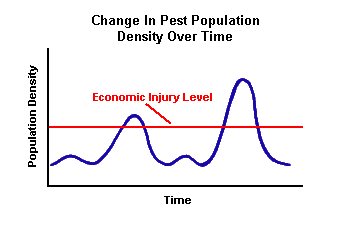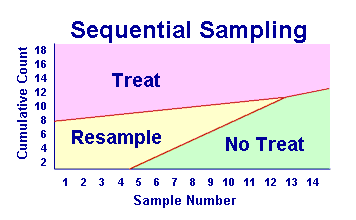Economic Injury Level
The break-even point, where “A”=”B”, is known as the economic injury level. This is the population density at which the cost to control the pest equals the amount of damage it inflicts (actual or potential). Below the economic injury level, it is not cost-effective to control the pest population because the cost of treatment (labor plus materials) would exceed the amount of damage. Above the economic injury level, however, the cost of control is compensated by an equal or greater reduction in damage by the pest.
The economic injury level (EIL) is often expressed mathematically by the formula:

where:
- “C” is the unit cost of controlling the pest (e.g., $20/acre)
- “N” is the number of pests injuring the commodity unit (e.g., 800/acre)
- “V” is the unit value of the commodity (e.g., $500/acre)
- “I” is the percentage of the commodity unit injured (e.g., 10% loss)
For the example given above, the economic injury level would equal 320 insects per acre:

The economic injury level is usually expressed as a number of insects per unit area or per sampling unit. Occasionally, when the insects themselves are difficult to count or detect, the economic threshold may be based on a measurement of injury (e.g., leaf area consumed or number of dead plants).

It is important to recognize that the economic injury level is a function of both the cost of pest control and the value of a commodity or product. Some commodities may be worth so little that it is never worth saving them from insect injury.
More about
Different Values The value of other commodities may be so great that any level of infestation is worthy of control. Because of its dependence on both cost and value, the economic injury level can be calculated only after establishing a value for the damaged commodity or product. In practice, this can sometimes be a difficult task because different people have different values.

 Any level of pest infestation causes injury, but not all levels of injury cause damage. Plants often tolerate small injuries with no apparent damage and sometimes even overcompensate by channelling more energy or resources into growth terminals or fruiting structures. A low level of injury may not cause enough damage to justify the time or expense of pest control operations. These sub-economic losses are simply part of the cost of doing business.
Any level of pest infestation causes injury, but not all levels of injury cause damage. Plants often tolerate small injuries with no apparent damage and sometimes even overcompensate by channelling more energy or resources into growth terminals or fruiting structures. A low level of injury may not cause enough damage to justify the time or expense of pest control operations. These sub-economic losses are simply part of the cost of doing business.


 The economic injury level is a useful concept because it quantifies the cost/benefit ratio that underlies all pest control decisions. In practice, however, it is not always necessary or desirable to wait until a population reaches the economic injury level before initiating control operations. Once it is determined that a population will reach outbreak status, prompt action can maximize the return on a control investment. Since there is usually a lag time between the implementation of a control strategy and its effect on the pest population, it is always desirable to begin control operations before the pest actually reaches the economic injury level.
The economic injury level is a useful concept because it quantifies the cost/benefit ratio that underlies all pest control decisions. In practice, however, it is not always necessary or desirable to wait until a population reaches the economic injury level before initiating control operations. Once it is determined that a population will reach outbreak status, prompt action can maximize the return on a control investment. Since there is usually a lag time between the implementation of a control strategy and its effect on the pest population, it is always desirable to begin control operations before the pest actually reaches the economic injury level. Unlike regular sampling protocols that require a fixed number of replications (usually 10-100), sequential sampling systems are designed to evaluate the data at the end of each sampling step. The total number of samples is variable, depending upon whether the cumulative data falls inside or outside of predetermined confidence intervals. Relatively few samples would be needed to recognize that a population is very small (well below the economic threshold) or very large (well above the economic threshold). But a larger number of samples (higher confidence) would be needed to decide whether an intermediate population should be treated or not treated.
Unlike regular sampling protocols that require a fixed number of replications (usually 10-100), sequential sampling systems are designed to evaluate the data at the end of each sampling step. The total number of samples is variable, depending upon whether the cumulative data falls inside or outside of predetermined confidence intervals. Relatively few samples would be needed to recognize that a population is very small (well below the economic threshold) or very large (well above the economic threshold). But a larger number of samples (higher confidence) would be needed to decide whether an intermediate population should be treated or not treated.